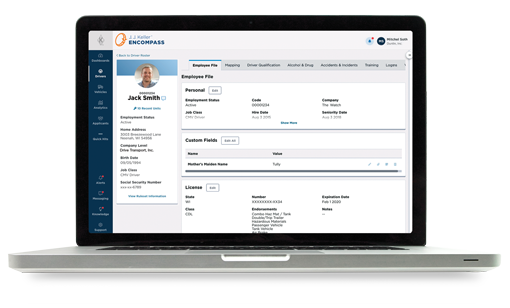Industry Business Advisor — J. J. Keller & Associates, Inc.
What Are Exempt Fleet Responsibilities Under FMCSA?
Compliance for 'exempt' fleets, much less any fleet, is challenging. Learn more about how the FMCSA rules apply to CMVs.
Published On: 01/29/2021


Written by:
Rick Malchow
To answer this question, we need to start with the general definition of a CMV (Commercial Motor Vehicle) – the broadest definition (49 CFR 390.5). At the core, the FMCSA (Federal Motor Carrier Safety Administration) defines CMVs as vehicles that operate in interstate commerce, on a highway, that weigh over 10,000 pounds (10,001 pounds or more).
It is important to remember that FMCSA doesn’t care how you get to 10,001 pounds – by actual weight or by the manufacturer’s rated carrying capacity, including the unit being driven plus any trailing units (in combination).
The definition also includes passenger-carrying vehicles that can carry more than eight for compensation and more than 15 passengers regardless of compensation. The last part of the definition includes any vehicle of any shape or size carrying a placardable amount of hazardous material.
So, when my vehicle meets this definition, what FMCSA rules do I have to follow?
It’s easier to answer what rules you DON’T have to follow if a driver does not require a CDL. There are precisely three parts that don’t apply to these vehicles and drivers:
- Special training requirements like LCVs (Longer Combination Vehicles) and entry-level drivers (Part 380)
- DOT Drug and Alcohol testing rules, and (Part 382)
- The requirements for CDLs and the corresponding licensee and endorsements (Part 383)
That leaves an ‘exempt’ fleet with a lot of rules to address. Here’s a list of the most commonly discussed Federal Motor Carrier Safety Regulations (FMCSRs):
- Part 365 OPERATING AUTHORITY
- Part 386 FMCSA PROCEEDINGS
- Part 366 PROCESS AGENTS
- Part 387 FINANCIAL RESPONSIBILITY
- Part 373 RECEIPTS AND BILLS
- Part 390 GENERAL REGULATIONS
- Part 374 PASSENGER CARRIER REGULATIONS
- Part 391 QUALIFICATIONS OF DRIVERS
- Part 376 LEASES
- Part 392 DRIVING CMVs
- Part 393 PARTS AND ACCESSORIES
- Part 395 HOURS OF SERVICE
- Part 396 INSPECTIONS
- Part 385 SAFETY FITNESS
- Part 397 HAZARDOUS MATERIALS DRIVING
The expectation from FMCSA is found in Section 390.3 in paragraphs (a) and (e) that all the FMCSRs apply to all carriers, drivers, and CMVs (including non-CDL), that transport people or property in interstate commerce.
Paragraph (e) is broken down into three sections.
- The first states that carriers need to know and follow the regulations. It’s essentially saying that “ignorance is no excuse.” You got to know them – all of them (or you better be partnering with someone who does).
- The second says that your drivers and employees have to be trained and comply with all the rules that apply to them. By the way, when it says employees, that means you, your managers, your mechanics, your dispatchers, your customer service folks, and whoever else in your organization “touches” transportation. NOTE: The FMCSA’s regulations consider your independent leased drivers to be employees.
- The last is about your vehicles – yes, even vehicles that are only sometimes a CMV – must be maintained in accordance with the rules, including all of the performance and design rules.
Is There Anything Else I Need to Do?
I wouldn’t be a subject matter expert if I didn’t remind you that FMCSA isn’t the only judge out there weighing your compliance and safety program.
TRIAL LAWYERS
One accident is all it takes for your compliance program to be exposed. Do you have proof that your files and training meet the standards? Even if you do, what steps are you taking to proactively protect your drivers and company? (May I suggest dash cameras? There’s nothing more powerful than video footage to stop litigation.)
INSURANCE COMPANIES
They are doing the research, and you can bet they will ask what you are doing to stay compliant and keep the motoring public safe. And like trial lawyers, they want proof.
GENERAL PUBLIC
It’s your name on the side of the truck. What are you saying to the general public through the way your driver is behaving on the road? Their behavior is speaking a lot louder than any commercial or social media post.
It’s Not Easy
Compliance for ‘exempt’ fleets, much less any fleet, is challenging. The rules are complex and differ based on vehicle size, driver credentials, and loads hauled. Unless you’re an expert at the regulations or only have one vehicle, it’s safe to say that having an extra set of eyes on your compliance program is a good idea.
Talk to a compliance specialist today about best practices and how you can ensure you comply with the rules that apply to you. And document your efforts! If you don’t have proof of your compliance, it’s like it never happened.
Hear from Our Experts!
Watch this episode of the DOT & ELD Regulatory Minute for guidance from J. J. Keller regulatory experts. Subscribe to our YouTube channel for the latest compliance & safety insights!
You may also enjoy the following articles:
Sign up for our newsletter!
We'll help you stay on top of regulations, best practices, and fleet industry news. Sign up to receive a monthly email notification with links to our most recent blog articles, free resources, and event invites.
